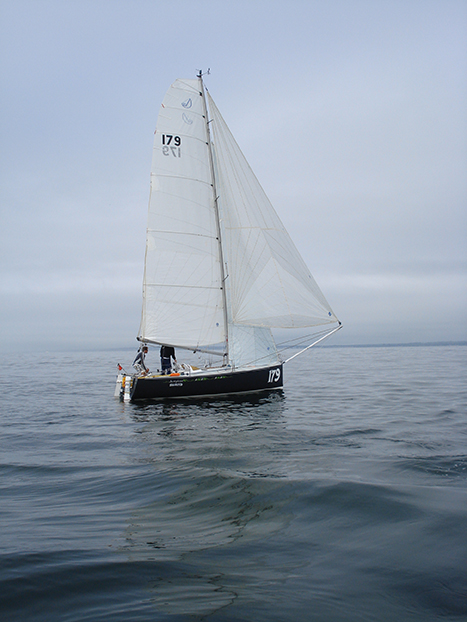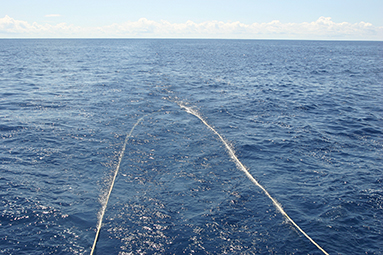Wheter alone or in the company of one or two others, shorthanded sailing means spending time on deck, alone and responsible for the safety of everyone else aboard (published June 2014)
It’s not always easy. In fact, sailing single or shorthanded can be exhausting at times. When confronted by heavy weather, serenity can seem elusive at best. On the other hand, with the advent of roller furling headsails, reliable autopilots and deck layouts that include control lines led aft to the cockpit, sailing alone or with one other capable crewmember can—and should be—a gratifying experience, enabling you to achieve goals previously thought impossible.
Years ago on a cool, cloudy morning, I raised the mainsail on a 60-foot Open Class monohull and left Plymouth, England bound for Newport, Rhode Island. I was alone. And it was the true beginning of my shorthanded sailing after years of sailing with full crews. In retrospect, and following 39 transatlantic passages, that first singlehanded trip entailed some of the worst weather I’ve encountered in the North Atlantic. With hundreds of thousands of miles behind me, I now find myself fortunate enough to help others achieve their own goals of short or singlehanded sailing.
While I still sail in a few races and do deliveries with full crews, I’m now sailing with an increasing number of people who would like to improve their own solo or shorthanded sailing skills. Some are successfully retired business people, living a dream that kept them going while working and raising a family. Some are couples putting in an effort to polish their skills so they can better help each other. And some are friends on their own adventure. At one time or another, each of them will find themselves alone on deck. I’ve been lucky to know and sail with them all—whether we’re sailing offshore on their C&C 35 or something a bit larger.
What does it mean, though, to be alone on deck, totally self-reliant or relying on only one other person? In reality, we can enlist support prior to departure and even have shoreside support while we’re underway, so it’s not really necessary to be totally sequestered any longer. Help can be a satellite phone call away. And yet, that is still only “words of wisdom” that is being offered. The shorthanded sailor still needs to be a jack-of-all-trades at times. Meals, maintenance and repairs, navigation and communications schedules, and sail selection all still need to be attended to, and it falls on the one or two people on board to do all of that.
Watchkeeping while doublehanding often assumes a fairly straightforward watch system. Aboard Great American II when Rich Wilson and I did the San Francisco to Boston and New York to Melbourne, Australia speed records, we had typical watch schedules. Four hours on, four hours off. With some doublehanded projects, I’ve done three hours on and three hours off so the watches aren’t as long. When I’ve sailed doublehanded with Lia Ditton, we occasionally even reverted to two hours on and two hours off during periods of heavy weather. Of course, that also means that the sleep periods are shortened.
Singlehanders have a somewhat more difficult situation when it comes to watchkeeping. As singlehanders, we are still responsible for the safe navigation of our vessels. It can certainly be argued that if the only person aboard is asleep, it is an irresponsible way of maintaining a watch. It can also be argued that with radar detectors—which have their own limitations—, proper sleep management and regular visual observations, one person can maintain a good watch. When I did my first singlehanded passage, I ate a modified macrobiotic diet in order to reduce the amount of sleep that I required. I only needed to sleep between four and six hours per day, and those times were generally in mid-morning and early evening. At night, I would meditate, reducing my own energy consumption while remaining aware of my surroundings. There are more sophisticated approaches, and Dr. Claudio Stampi has pioneered sleep awareness training for many singlehanders. His method of short naps has enabled Ellen MacArthur, Giovanni Soldini, J.P. Mouligne and many others to safely and successfully race singlehandedly around the world.
 When I am doublehanding with someone, I always request that if they have a question or a problem while I’m off watch, they should wake me up early to help with the situation. I find that it is quite a bit easier to avoid a problem rather than fix a problem or equipment failure. Whether encountering oncoming vessels in the middle of the night or deciding about a sail change, it is usually better to have a couple of sets of eyes and ideas rather than one. And if fatigue is an issue, doublehanders are often only four hours away from the next nap. It’s usually better to sacrifice a little sleep rather than the safety of the vessel, equipment or other person on board.
When I am doublehanding with someone, I always request that if they have a question or a problem while I’m off watch, they should wake me up early to help with the situation. I find that it is quite a bit easier to avoid a problem rather than fix a problem or equipment failure. Whether encountering oncoming vessels in the middle of the night or deciding about a sail change, it is usually better to have a couple of sets of eyes and ideas rather than one. And if fatigue is an issue, doublehanders are often only four hours away from the next nap. It’s usually better to sacrifice a little sleep rather than the safety of the vessel, equipment or other person on board.
Heavy weather can always present a challenge. Practice setting heavy weather sails, deploying warps and think through emergency procedures while sailing in good weather. You will have enough on your agenda when the weather turns bad, and there’s no need to be running through heavy weather tactics for the first time when storm conditions actually occur. A friend of mine once told me that if you sail long enough, everything will happen to you out there. Preparation will help avoid emergencies and turn them instead into “adventures.”
Sail changes are usually easier and more efficient when done early, whether sailing alone or with one other person. Of course, a hasty sail change may need to be reconsidered, but with roller furling headsails, changing down can often be relatively easy. If we’re going into the nighttime with unsettled conditions, I’ll often suggest reefing the main while daylight is still present. If less sail area is required later that night, rolling up a headsail can be quickly and easily executed—usually from the cockpit. And of course, clipping one’s harness to jack lines or a fixed point can prevent a personal disaster when going out of the cockpit in unsuitable conditions.
Storm sails should be set early. The first things we practice when I am sailing with people who are new to shorthanded sailing is setting the storm trysail and storm jib. While sailing in 10 to 15 knots of wind, we’ll actually put the storm trysail up in order to make sure that the gate on the main sail track works properly and is located in a convenient position. If there is a separate trysail track on the mast, having the gate a couple of feet above the bottom of the track will allow the trysail’s sliders to be put on the track from above. The sliders can be stacked without needing to hold them up while “loading the track” with the sail’s sliders. If you’ve only got one hand for the task and you are trying to hold on to the boat for your own safety, you will appreciate making the task as easy as possible.
 Often, if there isn’t a separate trysail track on the mast, having the gate located well above the stack of mainsail sliders is a good place to have access for the storm trysail. If the only way to get the mainsail track open for the trysail is to insert the sliders from the bottom of the track, then that implies before the trysail is put up that the main needs to be completely taken down off the track. In storm conditions it can be problematic to have the luff of the main detached from the track. Figure out how you’re going to set the storm trysail quickly and easily while you’re in comfortable conditions. When you need to do it in heavy weather, you’ll be glad to know that the difficulties have been resolved early.
Often, if there isn’t a separate trysail track on the mast, having the gate located well above the stack of mainsail sliders is a good place to have access for the storm trysail. If the only way to get the mainsail track open for the trysail is to insert the sliders from the bottom of the track, then that implies before the trysail is put up that the main needs to be completely taken down off the track. In storm conditions it can be problematic to have the luff of the main detached from the track. Figure out how you’re going to set the storm trysail quickly and easily while you’re in comfortable conditions. When you need to do it in heavy weather, you’ll be glad to know that the difficulties have been resolved early.
When doing long passages, I’ll often go aloft prior to the trip or during benign conditions to inspect the rig. Hopefully, that will save me a trip aloft during storm conditions to fix a problem that could have been avoided in the first place. Singlehanders of course can still get aloft by using self-ascending units such as ATN’s Top Climber.
Landfall is an occasion that we all look forward to. We know it’s coming. And we all know there can be some questions that will need to be addressed. What kind of sea state will we encounter as we get into shallower water? Will there be fishing boats or other traffic in the area? Will it be a daylight or nighttime approach? Will the weather be good or bad? We will be able to best deal with these questions and the situations they imply if we’re well rested and fed prior to making landfall. Rest up, charge batteries, and make sure quick and easy meals are readily available as you make your approach for the final day or two at sea.
When you’re sailing single or shorthanded, you still have assets you can draw upon. You—and your crew—are still the most valuable assets aboard the boat. So sharpen your skills early, and take care to protect your most important resources: you, your crew and your boat.
Bill Biewenga is a navigator, delivery skipper and weather router. His websites are www.weather4sailors.com and www.WxAdvantage.com. He can be contacted at billbiewenga@cox.net















